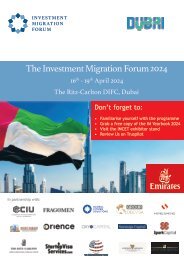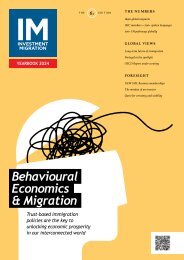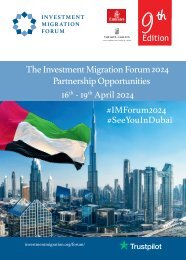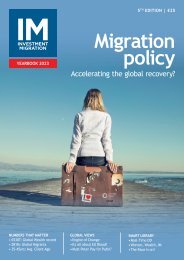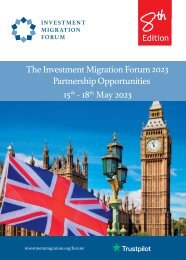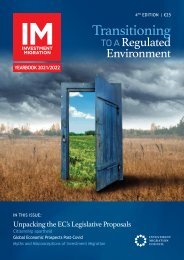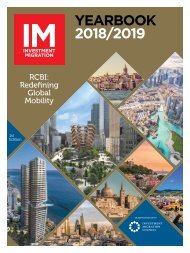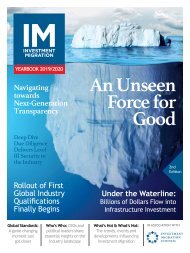IM Yearbook 2020/21
Born from the need for a global, credible, “go-to” publication, the 3rd IM Yearbook offers valuable access to a prime target audience of top industry influencers, decision makers, and the foremost referral network to the world’s most influential Investment Migration programmes: Government officials such as Heads of CIU’s, policy makers, academics, migration agents, law firms, wealth managers, financial advisors, real estate developers, and international firms involved in investment migration.
Born from the need for a global, credible, “go-to” publication, the 3rd IM Yearbook offers valuable access to a prime target audience of top industry influencers, decision makers, and the foremost referral network to the world’s most influential Investment Migration programmes: Government officials such as Heads of CIU’s, policy makers, academics, migration agents, law firms, wealth managers, financial advisors, real estate developers, and international firms involved in investment migration.
You also want an ePaper? Increase the reach of your titles
YUMPU automatically turns print PDFs into web optimized ePapers that Google loves.
What are SDGs?<br />
They are a set of 17 SDGs<br />
and 169 targets that are<br />
applicable to different national<br />
realities, including advanced<br />
nations, middle-income developing<br />
and emerging economies, small<br />
island states, least developed<br />
countries and post-conflict nations.<br />
Can you please give<br />
us a brief introduction<br />
to the United Nations<br />
Sustainable Development<br />
Goals and explain what<br />
they aim to achieve?<br />
The United Nations<br />
Sustainable Development<br />
Goals (SDGs), adopted in<br />
2015, provide an international<br />
framework to create more<br />
sustainable and fair economies<br />
as well as resilient and<br />
prosperous societies by 2030.<br />
They are a set of 17 SDGs and<br />
169 targets that are applicable<br />
to different national realities,<br />
including advanced nations,<br />
middle-income developing and<br />
emerging economies, small<br />
island states, least developed<br />
countries and post-conflict<br />
nations. The SDGs include<br />
initiatives to end poverty,<br />
ensure quality education,<br />
achieve gender equality,<br />
promote decent jobs and<br />
take urgent action to combat<br />
climate change and its impacts.<br />
The SDGs are not the<br />
first initiative of this kind.<br />
They were preceded by the<br />
Millennium Development<br />
Goals (MDGs) that were<br />
agreed upon in 2000. The<br />
SDGs are a second and more<br />
ambitious step in realising a<br />
global development agenda.<br />
The MDGs promoted<br />
economic growth combined<br />
with social equity and<br />
environmental protection.<br />
The SDGs take on a more<br />
comprehensive and holistic<br />
approach to development,<br />
sensitive to our ecological<br />
and planetary boundaries<br />
besides promoting poverty<br />
reduction and lower inequality.<br />
What capital investment<br />
is required to implement<br />
the SDGs?<br />
The United Nations Conference<br />
on Trade and Development<br />
(UNCTAD) in 2015 estimated<br />
global investment needs<br />
between $5 to $7 trillion<br />
per year to achieve the<br />
SDGs. Developing countries<br />
require around $4 trillion<br />
per year, mostly in terms of<br />
infrastructure investment such<br />
as power, transport, water<br />
and sanitation. Clearly, we<br />
cannot meet the SDGs only by<br />
utilizing public funds; private<br />
support is required too. The<br />
issue is more complicated for<br />
low income countries as they<br />
have to achieve the same set of<br />
goals but have fewer internal<br />
financing resources. Botswana,<br />
Ghana or Sri Lanka, for<br />
example, cannot be compared<br />
with Switzerland, Sweden<br />
or Germany in their ability<br />
to meet the SDGs. Besides,<br />
advanced economies have<br />
already achieved some goals,<br />
while developing nations<br />
have a long way to go.<br />
Beyond the country<br />
differences, is the world<br />
on track to achieving the<br />
SDGs and is Covid-19<br />
threatening progress?<br />
The UN Secretary General<br />
appointed the Independent<br />
Group of Scientist to monitor<br />
the progress in achieving<br />
the SDGs. They produced a<br />
report in 2019 and concluded<br />
that the world is still far<br />
away from reaching the<br />
goals. For instance, we have<br />
seen insufficient progress in<br />
terms of reducing poverty in<br />
Africa and low-income Asia.<br />
Furthermore, climate change<br />
is one of the biggest challenges<br />
of our time and stopping or<br />
reversing global warming<br />
is a slow-moving process.<br />
Covid-19 is definitely a setback,<br />
hopefully of a temporary<br />
nature. The world economy<br />
in <strong>2020</strong> will experience the<br />
greatest recession since the<br />
Great Depression in the 1930s.<br />
Estimates by international<br />
organisations are that GDP will<br />
contract by 6% to 7% worldwide<br />
this year with positive<br />
growth in 20<strong>21</strong>. However, the<br />
pandemic presents both an<br />
enormous challenge and also<br />
opportunities for reaching<br />
the SDGs. Gains in economic<br />
and social progress made in<br />
recent years are reversed. The<br />
pandemic has also shown us<br />
how interconnected people<br />
and countries are for good<br />
or bad, for example the virus<br />
spread with utmost speed<br />
across the world through<br />
travel and people mobility<br />
in a few weeks. The crisis is<br />
forcing us to re-look at the<br />
way forward and come up<br />
with new solutions that truly<br />
balance economic, social and<br />
environmental progress. In<br />
this sense, the SDGs provide<br />
good priorities although<br />
we need more in terms of<br />
devising concrete strategies<br />
for effective recovery and for<br />
ensuring health and safety.<br />
Investment Migration <strong>Yearbook</strong> 2O2O/2O<strong>21</strong> 41




